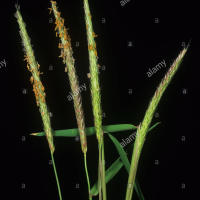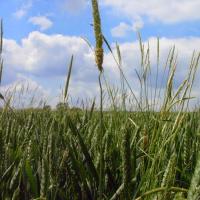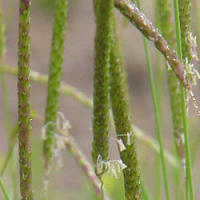Blackgrass
Alopecurus myosuroides
Detailed Appearance:
Black-grass is an annual grass with a tufted growth habit, reaching heights of 30 to 90 centimeters. The leaves are flat, linear, and often have a distinctive blue-green color. The ligule (membranous structure where the leaf joins the stem) is short, and the seed head is a dense, cylindrical spike with awned florets.
Key Characters:
Key features of Alopecurus myosuroides include its tufted growth, blue-green leaves, and distinctive cylindrical seed head with awned florets. The awns are often twisted, contributing to the identification of this grass species.
Physiology:
As an annual grass, Black-grass completes its life cycle within a single growing season. It reproduces primarily by seeds, and the awns on the seeds aid in their dispersal. The plant is known for its ability to germinate in both autumn and spring, making it challenging to control in agricultural fields.
Population Dynamics:
Alopecurus myosuroides is a problematic weed in cereal crops, particularly wheat and barley fields. It competes with crops for resources and, due to its adaptability, can form dense populations, reducing crop yields.
Dispersal:
The primary mode of seed dispersal for Black-grass is through its awned seeds. The twisted awns allow the seeds to attach to fur or clothing, facilitating dispersal by animals or human activities. Wind can also play a role in short-distance seed dispersal.
Habitat Preferences:
Black-grass is commonly found in arable fields, especially those under intensive cultivation. It thrives in disturbed habitats and can quickly establish in fields where it competes with crops for nutrients, water, and sunlight.
Growth Cycle:
As an annual grass, Alopecurus myosuroides germinates in the autumn or spring, grows through the vegetative and reproductive stages, produces seeds, and then dies off. The ability to germinate in both seasons contributes to its persistence in agricultural settings.
Ecological Impact:
Black-grass is considered a problematic weed in agriculture, affecting crop production. Its competitive nature, adaptability to various environments, and ability to quickly establish dense populations make it challenging for farmers to manage.
Control Measures:
Effective control measures for Alopecurus myosuroides in agriculture involve a combination of cultural, mechanical, and chemical methods. Crop rotation, early sowing, and proper herbicide use are common strategies to manage this weed and reduce its impact on crop yields.
Human Interaction:
Black-grass interacts with human activities in agricultural landscapes. Farmers and agricultural researchers are focused on developing and implementing effective control strategies to minimize the impact of this weed on crop production. Understanding its growth cycle and dispersal mechanisms is crucial for successful management.









